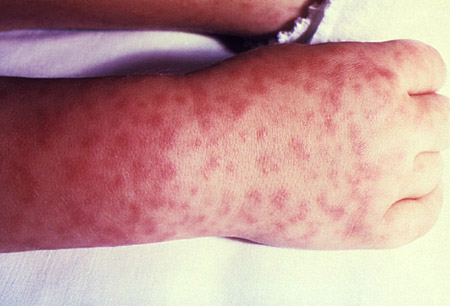Last reviewed: 16 Mar 2025
Last updated: 24 Apr 2024
Summary
Definition
History and exam
Key diagnostic factors
- known recent tick exposure or bite
- triad of fever, rash, and history of tick exposure
- triad of fever, rash, and headache
- fever
- rash
- headache
- nausea/vomiting
- myalgia
- altered mental status
Other diagnostic factors
- abdominal pain
- residence in or recent exposure to rural area
- diarrhoea
- conjunctivitis
- lymphadenopathy
- peripheral oedema
- meningismus
- splenomegaly
- hepatomegaly
- jaundice
- seizures
- shock
- coma
Risk factors
- illness onset in spring or summer
- returned travellers from an endemic area
- recent (within 2 weeks) outdoor exposure
- known antecedent tick bite
- exposure to dogs or pets that spend time outdoors
Diagnostic investigations
1st investigations to order
- FBC
- serum electrolytes and urea
- LFTs
- indirect immunofluorescent antibody
- blood culture
Investigations to consider
- complement fixation
- latex agglutination
- indirect haemagglutination
- microagglutination
- enzyme immunoassay
- lumbar puncture
- convalescent serology
- chest x-ray
- abdominal CT scan
- immunohistochemistry
- polymerase chain reaction
Treatment algorithm
Contributors
Authors
Christopher A. Ohl, MD
Professor of Medicine
Section on Infectious Diseases
Wake Forest School of Medicine
Winston-Salem
NC
Disclosures
CAO declares that he has no competing interests.
Acknowledgements
Professor Christopher A. Ohl would like to gratefully acknowledge Dr Steven C. Buckingham, a previous contributor to this topic. SCB is an author of several references cited in this topic. We were made aware that Dr Steven C. Buckingham is now deceased.
Peer reviewers
Mary Anne Jackson, MD
Chief
Section of Pediatric Infectious Diseases
Children's Mercy Hospital and Clinics
Professor of Pediatrics
University of Missouri-Kansas City School of Medicine
Kansas City
MO
Disclosures
MAJ is an author of several references cited in this topic.
Use of this content is subject to our disclaimer
